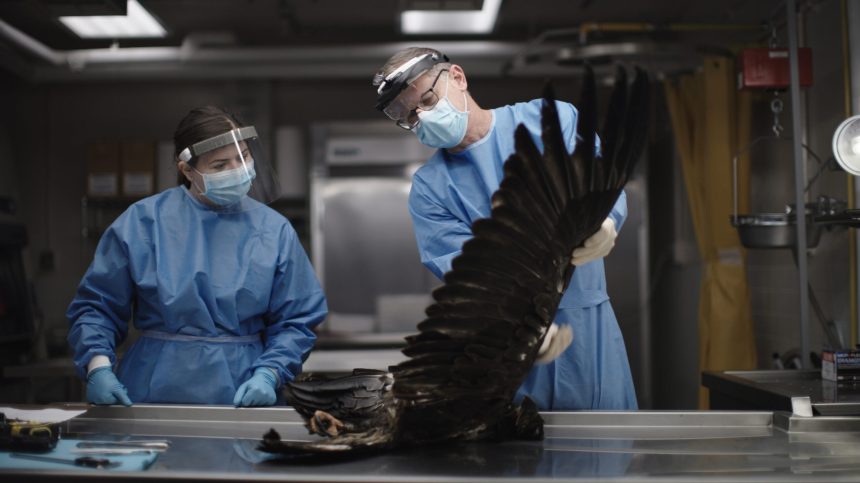By Jim Curcuruto, Outdoor Stewards of Conservation Foundation
With human viruses and diseases dominating news headlines for months, I wanted to learn more about what wildlife biologists and veterinarians do, funded by Pittman-Robertson dollars, to combat diseases in wildlife populations.
Tracking and studying wildlife diseases is a crucial part of wildlife management, according to Dr. Colin Gillin, State Wildlife Veterinarian at the Oregon Department of Fish and Wildlife (ODFW) Health and Population Laboratory. He provided some details.
“There are many wildlife diseases present in nature,” said Gillin. “Some of the more well-known ones include Chronic Wasting Disease, Epizootic Hemorrhagic Disease, Highly Pathogenic Avian Influenza, Newcastle Disease and White-Nose Syndrome.”
Perhaps the most notorious of these is Chronic Wasting Disease (CWD), a contagious and fatal neurological disease in deer, elk and moose. With CWD identified in more than half of states in the U.S., and new cases found regularly, it is rightfully high on the list of diseases that experts are tasked to study and combat.
“CWD has been on our radar for almost 20 years,” said Gillin. “We started collecting tissue samples to study the disease back in 2002.” Oregon is blessed with diverse habitats that support populations of black-tailed deer, white-tailed deer, mule deer, moose, Roosevelt elk, and rocky mountain elk making CWD a major concern for ODFW.
Obtaining samples to study proved a daunting and costly task until community partners, including hunters, stepped in to help. “We can test up to 3,000 samples annually with hunters playing a key role in suppling samples,” said Gillin. “Without hunter support, and funding from Pittman-Robertson dollars, we would not know as much as we do about CWD.”
Because of the hard work from wildlife biologists and state veterinarians, wildlife agencies know that the best way to combat CWD is to limit movement and transportation of cervids and to monitor captive populations closely for outbreaks. Communication strategies have been put in place to spread these best practices. State restrictions, such as a ban on importing potentially infected spinal columns and brain matter of deer, elk and moose into Oregon, help limit the spread of CWD.
Waterfowl and Highly Pathogenic Avian Influenza comes under Gillin’s bailiwick, too. “Certain waterfowl, particularly mallards and pintails, can be primary carriers of this disease, which can be transmitted between wild birds and domesticated flocks.” Through Pittman-Robertson-funded research, much has been learned about how to stop the spread of this virus, and veterinarians communicate tried-and-true prevention measures to stakeholders.
“A key to preventing transmission of diseases such as Avian Influenza is increased awareness and practicing of biosecurity,” said Gillin. “We inform folks of the importance to keep domestic and wild birds separate and to not allow shared water sources. It doesn’t matter if it is a large-scale poultry factory or an individual with a few pet ducks, precautions need to be taken to avoid the transmission of avian diseases.”
Each state wildlife agency has to grapple with local circumstances. Tricia Hosch-Hebdon, Natural Resource Program Coordinator for the Idaho Fish and Game Department (IFGD), noted, “States face many of the same challenges when it comes to wildlife diseases but we each have our own unique focuses as well.”
Treponeme-Associated Hoof Disease (TAHD) in Idaho’s elk population is a top priority as is Rabbit Hemorrhagic Disease Virus. “With the help of Pittman Robertson funds, we are able to conduct research on multiple wildlife diseases to identify the best way to keep them in check,” said Hosch-Hebdon. “Maintaining a healthy elk population is very important to us. Through constant disease surveillance we will be able to have early detection of Elk Hoof Disease caused by TAHD and we have a plan in place to minimize its spread if and when outbreaks occur.”
Falconers recently reported to the IFGD several dead jackrabbits in a concentrated area. The IFGD determined Rabbit Hemorrhagic Disease Virus as the cause. “The last thing we want is for this virus to spread to domestic animals or to species of special concern such as the pika and pygmy rabbits,” said Hosch-Hebdon.

But if not for Pittman-Robertson dollars, the Indiana Department of Natural Resources (IDNR) may not have addressed diseases afflicting wildlife populations to the level it has for the last two decades. According to Mitch Marcus, IDNR’s Assistant Director of the Office of Science and Research, Pittman-Robertson affords its labs the opportunity to hire staff, pay for diagnostic work, and research and surveil wildlife for disease.
Federal grant programs like Wildlife & Sportfish Restoration (WSFR) have provided Indiana Department of Natural Resources (DNR) Division of Fish & Wildlife (DFW) the opportunity to develop a fish and wildlife health program. “These grant programs have afforded us the opportunity to hire staff, fund diagnostic work, conduct surveillance, respond to wild animal health emergencies and conduct research. For the past 20 years, we use these funds to investigate fish and wildlife health issues such as: high pathogenic avian influenza (HPAI), avian cholera, viral hemorrhagic septicemia (VHS), epizootic hemorrhagic disease (EHD) bovine tuberculosis (bTB), white-nose syndrome (WNS), West Nile virus (WNV), botulism, rabies, and parasitism.”
Indiana, Idaho, and Oregon are vastly different places, yet they must deal with wildlife diseases in common, such as Epizootic Hemorrhagic Disease, CWD, Avian Influenza and more, which speak to the ubiquity of such ailments in nature. State fish and wildlife agencies also have in common the reliable and consistent funding available to them via Pittman-Robertson dollars to see the work through.
To learn more about Pittman-Robertson, visit Partner with a Payer

